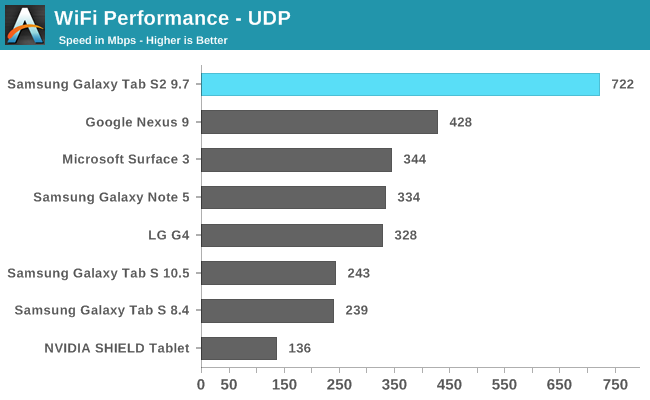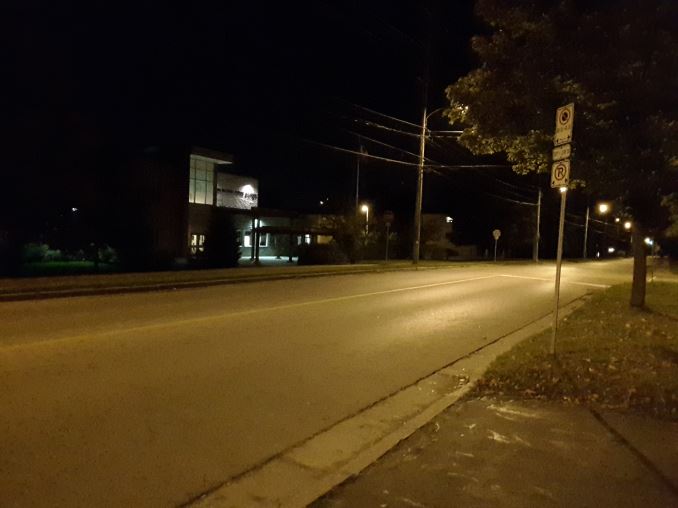The Samsung Galaxy Tab S2 Review
by Brandon Chester on October 15, 2015 8:00 AM ESTCamera: Photos and Videos
The number of users that use their tablet as their primary camera is far larger than anyone ever could have predicted when the tablet market was emerging. However, there are some obvious reasons why someone would opt for their tablet. It may actually be the best camera they own, and older users with aging eyes can definitely appreciate the fact that their tablet display turns into a giant high resolution viewfinder. The cameras themselves have also improved significantly from the dark days of the 1.2MP rear camera on the iPad 2.
Since the Tab S2 is extremely thin, Samsung has needed to allow for a camera hump in order to fit their 8MP sensor. The hump isn't very large, and although it's larger than that of the iPhone 6, it's not near as large as the camera hump on the Galaxy S6. It's honestly not really an issue, but some customers who are very serious about the design of their devices may take issue with it.
Below you can view the known specifications of the Tab S2's rear and front-facing cameras. Unfortunately I don't have data on the specific model of the rear-facing sensors used in the original Tab S series, so that info is omitted on the chart.
| Camera Specifications | ||||
| Galaxy Tab S1 Series | Galaxy Tab S2 Series | |||
| Front Camera | 2.1MP (1920x1080) |
|||
| Front Camera - Sensor | S5K6B2 (1.34 µm, 1/6") |
|||
| Front Camera - Focal Length | N/A | 27mm eff | ||
| Front Camera - Max Aperture | F/2.4 | F/2.2 | ||
| Rear Camera | 8.0MP (3264x2448) |
|||
| Rear Camera - Sensor | N/A (1.12 µm, 1/4") |
S5K4H5 (1.12 µm, 1/4") |
||
| Rear Camera - Focal Length | 32mm eff | 31mm eff | ||
| Rear Camera - Max Aperture | F/2.4 | F/1.9 | ||
While Samsung hasn't made any radical changes to the camera sensor specifications with the Tab S2, they have significantly widened the rear-facing camera's aperture. Changes to image processing and ISP improvements will also have an enormous impact on image quality.
As always, my photo testing begins with a scene during the day, followed by that same scene at night to test low light performance. While the low light test is still pretty brutal on current tablets, it's a very good indicator of the quality of an OEM's image processing.
During the day the Tab S2 performs very well. Detail is on par with the iPad Air 2, which isn't surprising given the similar sensors and Samsung's large improvements in image processing quality this year. My only complaint is that there is a bit too much sharpening going on which exacerbates the artifacting on the wall of the building caused by the limited effective resolution of the camera system. What's interesting is that the Galaxy S6 Edge processes the image with less sharpening, which is likely intentional on Samsung's part as the S6 has a much larger sensor with a higher resolution. Overall, I'm happy with the Tab S2's camera quality, and I'm glad Samsung decided to give the tablet a bit of a camera hump instead of crippling the camera quality to fit in the 5.6mm profile of the chassis.
Low light photography is where I started to have some issues taking photos with the Tab S2. For some reason it simply refused to run the autofocus, and I had to try and manually focus by tapping which is difficult on such a large device. Once I was able to focus and take the shot I took a few, and the best result is the one you see above. For a tablet it's actually a pretty good photo, although as you can see from the street lamps the photo is definitely overexposed to a degree. Compared with the iPad Air 2 there's actually not much more visible in the frame despite the overexposure, and the Air 2 has a better rendition of the grassy patch on the right side as well as the no parking sign. Both photos are still very good as far as tablets go, but I do think the iPad wins out by a little bit because of the exposure and slightly better detail preservation.
The Tab S2 can record video at 1080p30, and also at 1440p30 although the latter disables video stabilization and so I've opted to just use the 1080p recording mode. Looking back at all the tablets I've evaluated, it's clear that the Tab S2 has the best video recording quality by far. It's definitely not perfect, with some jiggle to the frames caused by the EIS and a bit too much saturation to the colors, but the overall quality, sharpness, and consistency of the frame rate is better than any other device I've tested.
WiFi Performance
Like the original Tab S, the Tab S2 ships with a 2x2 802.11ac WiFi implementation. I actually haven't been able to track down exactly which WiFi chipset they're using, which is unfortunate. The original Tab S actually had strangely slow WiFi performance given its peak theoretical bandwidth of 866Mbps, and I was hopeful that the Tab S2 would fare better.

As you can see, the WiFi performance on the Tab S2 is miles ahead of the previous models, and ends up having the highest peak bandwidth on record for a mobile device. Samsung did a great job improving on last year's WiFi implementation, and if there's going to be any bottleneck over WiFi it's not likely that t it will be the Tab S2.























162 Comments
View All Comments
theduckofdeath - Sunday, October 18, 2015 - link
Because tablets really, really benefit from every mm or gram lost. It's not rocket science.nathanddrews - Thursday, October 15, 2015 - link
For $500, I'd rather just get a Surface 3...lilmoe - Thursday, October 15, 2015 - link
+1That would be my only choice for that price range. But the Surface Pro 3 is on sale for ~$630, so I'd go for that.
lilmoe - Thursday, October 15, 2015 - link
Also, for the extra ~$100 in cost (plus ~100 for the type cover), you're getting a device that will easily outperform any ARM tablet in performance, and outlast them in OS/software support. You won't have to worry about planned obsolescence in performance and support either.If Microsoft releases a 10" Surface 4 (non-pro) with a Core M3/M5, it would be the perfect tablet in its class, even if it still had the same resolution (1920x1280).
Alexey291 - Thursday, October 15, 2015 - link
Instead you have to worry about using Windows. I'm sorry but the last thing I want in my dedicated browsing device / content consumption device is having bsods (yup they still happen) or viruses/trojans.Let alone the rest of Windows bullshit which is the prime reason why so many people got arm tablets in the first place. To get away from Windows.
steven75 - Thursday, October 15, 2015 - link
Yep, the problem with the Surface is Windows. The hardware is mostly fine.wavetrex - Thursday, October 15, 2015 - link
Can you install Linux on Surface ? :)That would be fun... MICROSOFT Surface, Powered by LINUX :)
thedons1983 - Saturday, October 17, 2015 - link
Linux is shit! Anyone that uses it, has a penchant for pain and suffering...thedons1983 - Saturday, October 17, 2015 - link
And what OS what you replace it with exactly? iOS is shit, as is OS X. Linux is crap, Android isn't a fully fledged OS... So what are you using, that's so great??lilmoe - Thursday, October 15, 2015 - link
Windows is a plus. Windows was never a downside except for those "YES", "OK", "Go Ahead and Install" (because you won the lottery) go happy pop-up clickers.Let's be honest here, those who use ARM tablets for anything other than browsing and watching youtube are a very small minority.